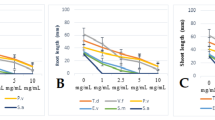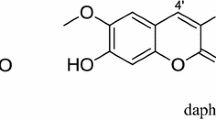Abstract
Spiraea thunbergii Sieb. contains 1-O-cis-cinnamoyl-β-d-glucopyranose (CG) and 6-O-(4′-hydroxy-2′-methylene-butyroyl)-1-O-cis-cinnamoyl-β-d-glucopyranose (BCG) as major plant growth inhibiting constituents. In the present study, we determined the inhibitory activity of CG and BCG on root elongation of germinated seedlings of lettuce (Lactuca sativa), pigweed (Amaranthus retroflexus), red clover (Trifolium pratense), timothy (Phleum pratense), and bok choy (Brassica rapa var chinensis) in comparison with that of two well-known growth inhibitors, 2,4-dichlorophenoxyacetic acid (2,4-D) and (+)-2-cis-4-trans-abscisic acid (cis-ABA), as well as two related chemicals of CG and BCG, cis-cinnamic acid (cis-CA) and trans-cinnamic acid (trans-CA). The EC50 values for CG and BCG on lettuce were roughly one-half to one-quarter of the value for cis-ABA. cis-Cinnamic acid, which is a component of CG and BCG, possessed almost the same inhibitory activity of CG and BCG, suggesting that the essential chemical structure responsible for the inhibitory activity of CG and BCG is cis-CA. The cis-stereochemistry of the methylene moiety is apparently needed for high inhibitory activity, as trans-CA had an EC50 value roughly 100 times that of CG, BCG, and cis-CA. Growth inhibition by CG, BCG, and cis-CA was influenced by the nature of the soil in the growing medium: alluvial soil preserved the bioactivity, whereas volcanic ash and calcareous soils inhibited bioactivity. These findings indicate a potential role of cis-CA and its glucosides as allelochemicals for use as plant growth regulators in agricultural fields.
Similar content being viewed by others
References
ARAI, S., TODOROKI, Y., IBARAKI, S., NAOE, Y., HIRAI, N, and OHIGASHI H. 1999. Synthesis and biological activity of 3′-chloro, -bromo, and -iodoabscisic acids, and biological activity of 3′-fluoro-8′-hydroxyabscisic acid. Phytochemistry 52:1185–1193.
BALINOVA, A. M. and MONDESKY, M. 1999. Pesticide contamination of ground and surface water in Bulgarian Danube plain. J. Environ. Sci. Health B 34:33–46.
BAZIRAMAKENGA, R., SIMARD, R. R., and LEROUX, G. D. 1994. Effects of benzoic and cinnamic acids on growth, mineral composition, and chlorophyll content of soybean. J. Chem. Ecol. 20:2821–2833.
BONNER, J. and GALSTON, A. W. 1944. Toxic substances from the culture media of guayule which may inhibit growth. Bot. Gaz. 106:185–198.
CHON, S. U., KIM, Y. M., and LEE, J. C. 2003. Herbicidal potential and quantification of causative allelochemicals from several Compositae weeds. Weed Res. 43:444–450.
CROSBY, D. G. 1998. Biotransformations, pp. 95–121, in Environmental Toxicology and Chemistry. Oxford University Press, NY.
FAO. 1998. World Reference Base for Soil Resources. World Soil Resources Reports 84, FAO, Rome.
FUJITA, K. and KUBO, I. 2003. Synergism of polygodial and trans-CA on inhibition of root elongation in lettuce seedling growth bioassays. J. Chem. Ecol. 29:2253–2262.
HALL, J. C., VandEYNZE, T. D., STRUGER, J., and CHAN, C. H. 1993. Enzyme-immunoassay based survey of precipitation and surface-water for the presence of atrazine, metolachlor and 2,4-D. J. Environ. Sci. Health B 28:577–598.
HIRADATE, S. and UCHIDA, N. 2004. Effects of soil organic matter on pH-dependent phosphate sorption by soils. Soil Sci. Plant Nutr. 50:665–675.
HIRADATE, S., MORITA, S., SUGIE, H., FUJII, Y., and HARADA, J. 2004. Phytotoxic cis-cinnamoyl glucosides from Spiraea thunbergii. Phytochemistry 65:731–739.
KOSHMIZU, K., FUKUI, H., MITSUI, T., and OGAWA, Y. 1966. Identity of lupin inhibitor with abscisin II and its biological activity on growth of rice seedlings. Agric. Biol. Chem. 30:941–943.
LI, H., INOUE, M., NISHMURA, H., MIZUTANI, J., and TSUZUKI, E. 1993. Interactions of trans-cinnamic acid its related phenolic allelochemicals, and abscisic acid in seedling growth and seed germination of lettuce. J. Chem. Ecol. 19:1775–1787.
MORITA, S., ITO, M., FUJII, Y., and HARADA, J. 2001. Plant growth inhibiting effect in arbor plants. J. Weed Sci. Technol. 46 (supplement): 134–135. (in Japanese)
NAKANO, S., TODOROKI, Y., HIRAI, N., and OHIGASHI, H. 1995. Synthesis and biological activity of 7′-, 8′-, and 9′-alkyl analogues of abscisic acid. Biosci. Biotech. Biochem. 59:1699–1706.
PIERZYNSKI, G. M., SIMS, J. T., and VANCE, G. F. 2000. Our environment: atmosphere and hydrosphere, pp. 21–56, in Soils and Environmental Quality. 2nd ed., CRC Press, Boca Raton, FL.
SOIL SURVEY STUFF. 1999. Key to Soil Taxonomy, 6th edn. Soil Conservation Service/USDA, Washington, D.C.
SUN, F.-M., SMITH, J. L., VITTIMBERGA, B. M., and TRAXLER, R. W. 2002. Effect of food processing on bioactive compounds in foods: A new method for separation and identification of cis-cinnamic acid from its racemic mixture, pp. 228–240, in Bioactive Compounds in Foods, American Chemical Society, ACS Symposium Series 816.
TODOROKI, Y., NAKANO, S., ARAI, S., HIRAI, N., and OHIGASHI, H. 1997. Synthesis and biological activities of 8′-methylene- and 8′-methylidyneabscisic acids. Biosci. Biotech. Biochem. 61:2043–2045.
WOOD, J. A. and ANTHONY, D. H. J. 1997. Herbicide contamination of prairie springs at ultratrace levels of detection. J. Environ. Qual. 26:1308–1318.
YIN, Z., WONG, W., YE, W., and LI, N. 2003. Biologically active cis-cinnamic acid occurs naturally in Brassica parachinensis. Chin. Sci. Bull. 48:555–558.
Author information
Authors and Affiliations
Corresponding author
Rights and permissions
About this article
Cite this article
Hiradate, S., Morita, S., Furubayashi, A. et al. Plant Growth Inhibition By Cis-Cinnamoyl Glucosides and Cis-Cinnamic Acid. J Chem Ecol 31, 591–601 (2005). https://doi.org/10.1007/s10886-005-2047-0
Received:
Revised:
Accepted:
Issue Date:
DOI: https://doi.org/10.1007/s10886-005-2047-0




